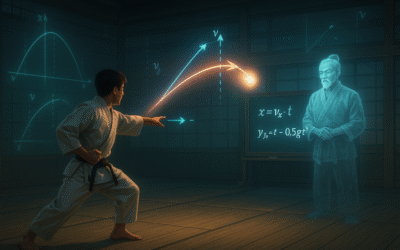🥋 Work and Energy – White to Black Belt Mastery
“Energy cannot be created or destroyed, only transformed.”
White Belt Level – Key Concept
Work and energy describe how forces cause motion and how motion is stored in different forms.
- Work transfers energy.
- Kinetic energy is energy of motion.
- Potential energy is stored energy due to position.
- The work-energy theorem says: Work = change in kinetic energy.
🎮 Explore: PhET Simulation – Work, Energy, and Power
Core Principles
- Work is force applied over a distance in the same direction.
- Kinetic energy: K = ½ m v².
- Potential energy (gravity): U = m g h.
- Conservation of Energy: Total energy stays constant in a closed system.
- Energy can transform (kinetic ↔ potential) but never disappears.
📖 Learn more: OpenStax University Physics, Ch. 6
Key Equations (SI Units)
- Work: W = F d cosθ (N·m = Joules, J)
- Kinetic energy: K = ½ m v² (J)
- Potential energy: U = m g h (J)
- Work-Energy Theorem: W_net = ΔK
- Conservation of Energy: E_total = K + U = constant
📄 Reference: OpenStax – Physics Formula Appendix
Common Mistakes and Pitfalls
- Forgetting the cosθ factor (work depends on angle).
- Mixing up energy types (potential vs kinetic).
- Assuming energy is “lost” (it usually transforms, often into heat or sound).
🔎 See also: HyperPhysics – Work and Energy
Sensei’s Shortcuts
⚡ Lift-and-Drop Rule: Lifting a mass by height h always increases potential energy by m g h, no matter the path.
Worked Example – Step by Step (White Belt)
Problem: A 5.00 kg box is lifted vertically by 2.00 m. How much work is done?
Step 1. Formula:
W = F d cosθ
Here F = weight = m g, d = height, θ = 0°
Step 2. Substitution:
W = (5.00 × 9.81)(2.00)(cos 0)
W = 49.1 × 2.00 × 1
Step 3. Final Answer:
W = 98.2 J
Practice Drill (White Belt)
- How much work is done lifting a 10.0 kg object 3.00 m?
Answer: W = 294 J - A force of 20.0 N pulls a box 4.00 m at 60°. How much work is done?
Answer: W = 40.0 J
Yellow Belt Extension – Deeper Skills
Problem: A 1,200 kg car moving at 20.0 m/s brakes to rest. How much work is done by the brakes?
Solution Outline:
- Work-energy theorem: W = ΔK
- Initial K = ½ (1,200)(20.0)² = 240,000 J
- Final K = 0
- ΔK = –240,000 J
Final Answer: Brakes do –240,000 J of work (energy removed).
🎮 Try the Bar Graphs tab in PhET Energy Skate Park.
📖 Extra reading: Khan Academy – Work and Energy
Black Belt Mastery – Exam Strategy and Challenge
Challenge Problem: A roller coaster (mass 500 kg) starts from rest at height 30.0 m. Neglect friction.
a) What is its speed at the bottom?
b) If friction does 20,000 J of negative work, what is the actual speed?
Strategy Notes:
- Use conservation of energy for part (a).
- Subtract frictional work from total energy for part (b).
Solution:
a)
Initial U = m g h = 500 × 9.81 × 30.0 = 147,000 J
K at bottom = 147,000 J
v = √(2K/m) = √(2 × 147,000 / 500) = 24.3 m/s
b)
Energy lost = 20,000 J
Remaining K = 147,000 – 20,000 = 127,000 J
v = √(2K/m) = √(254,000 / 500) = 22.6 m/s
Final Answers:
a) v = 24.3 m/s
b) v = 22.6 m/s
🚀 Related: NASA – Energy in Motion
Sensei’s Final Words
Energy is the currency of motion. Work spends it, forces transfer it, and conservation guarantees it never disappears. Train to see motion as an exchange of energy—this is mastery.


0 Comments